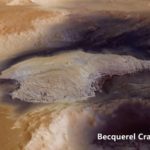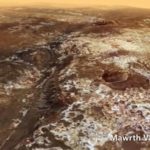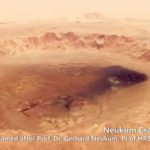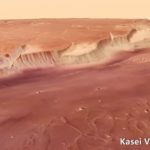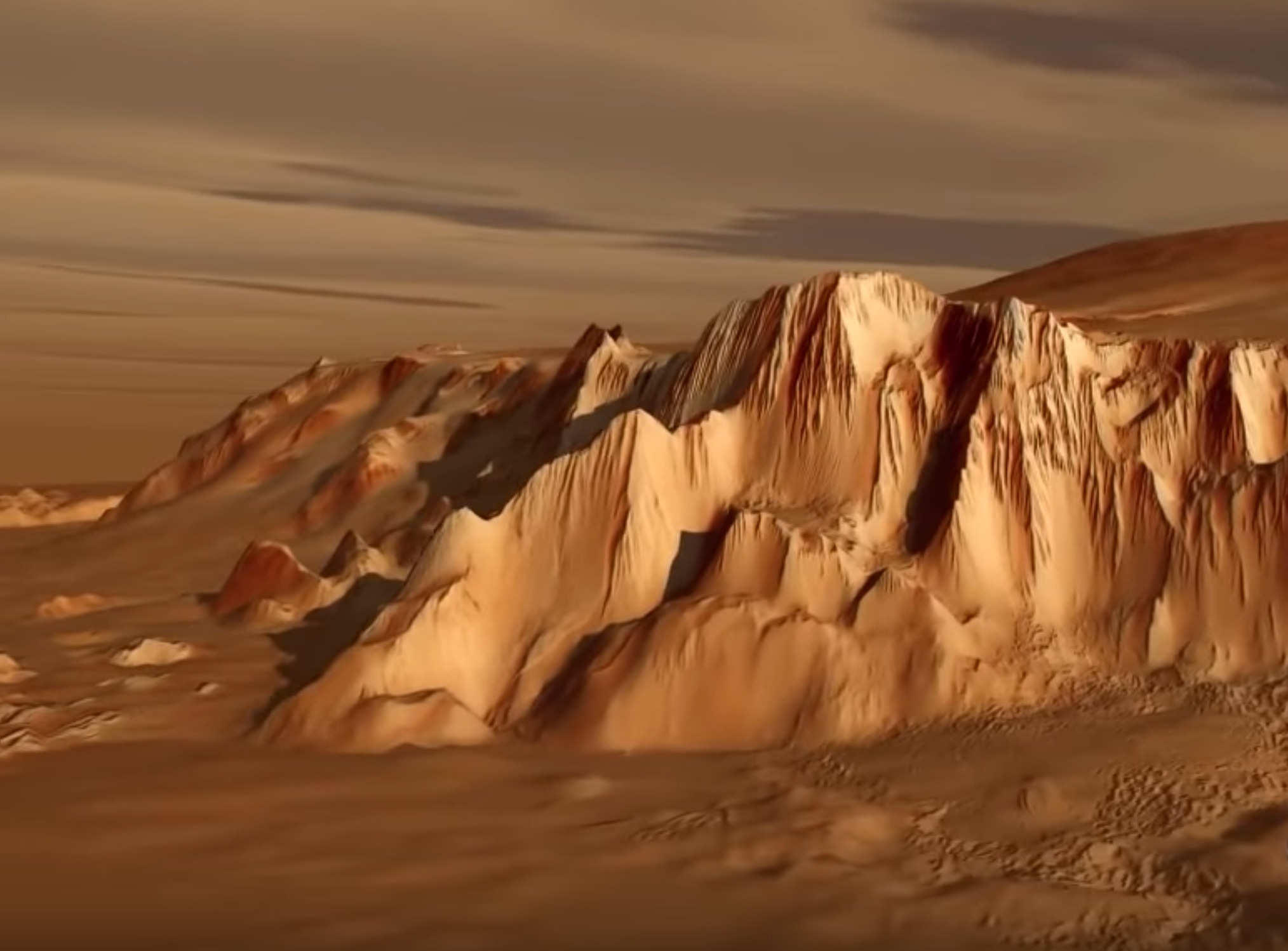
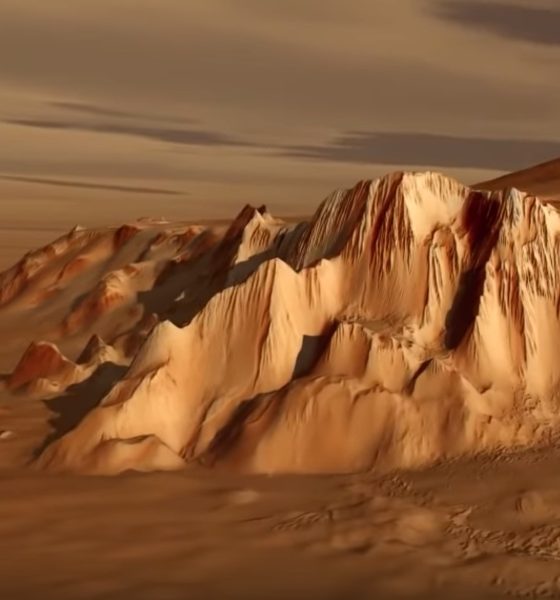
News
Europe’s space agency releases “best of Mars” video, showcasing 15 years of stunning satellite imagery
In a recap of its Mars Express imaging satellite’s fifteen years orbiting the red planet, the European Space Agency, NASA’s European equivalent, released a compilation video showcasing the most stunning photos captured by the craft. The animation added to the imagery gives viewers the impression of flying over the planet’s surface, taking in the depth of colors as though they were physically there themselves. With Mars in sight for near-future human exploration, ESA’s showcase gives Earth dwellers a taste of what’s to come.
The images in the collection demonstrate the great variation in geography across the cold, regolith-infused planet. Included in the photo set are the Neukum Crater, named after Gerhard Neukum, a German physicist, planetary scientist, and one of the founders of the Mars Express mission who died in 2014. The craters on Mars are generally representative of the planet’s ancient surface preserved for billions of years.
Also included is a flyover of the Kasei Valles, an “outflow channel” similar to the giant water-carved features of Earth, likely formed from a combination of tectonics, lava flow, and catastrophic flooding (potentially from the Echus Chasma, also included in the photos). Of course, ice-filled craters and the north and south polar ice caps are also included in the set, features of the planet that will be quite helpful to humans looking at long-term stays.
- The Becquerel Crater on Mars. | Credit: ESA/Mars Express
- The Mawrth Vallis on Mars. | Credit: ESA/Mars Express
- The Neukum Crater on Mars. | Credit: ESA/Mars Express
- The Kasei Valles on Mars. | Credit: ESA
To create the incredible imagery, photos taken by the Mars Express satellite during multiple passes were compiled into a mosaic. The instrument used to capture visuals is the High Resolution Stereo Camera (HRSC), and it has a resolution of about 32 feet, with some regions measured at about 6 feet of resolution. The HRSC can also create 3D imagery, capturing the planet’s topography at a level of detail that enables geoscientific evaluation of surface processes in space and time. The video compilation was assembled and edited by members of Freie Universitat Berlin’s Planetary Sciences and Remote Sensing department.
Mars Express was launched on June 2, 2003 aboard a Soyuz/Fregat rocket and received its name from being the quickest built planetary mission craft of its type. Its planned mission is to image the entire surface of Mars at high resolution and produce maps of the planet’s mineral compositions and atmospheric activities. A lander named Beagle 2 had traveled along with it, but unfortunately it became inoperable after successfully landing on the surface. Its fate remained unknown until NASA’s Mars Reconnaissance Orbiter located and photographed it in 2015.
Around winter holiday time last year, Mars Express captured images which formed the amazing “winter wonderland” photo showcasing the Korolev crater in the northern lowlands of Mars. Since the satellite entered orbit around the planet on December 25, 2003, the capture was both relevant to the craft’s history and timely for the season. Yet another geographic phenomenon was on display with this surface feature – “cold trap” – where air moving across the crater cools, becoming heavy and getting “trapped” directly above the ice.
Watch the full video released by ESA below:

News
Tesla FSD fleet is nearing 7 billion total miles, including 2.5 billion city miles
As can be seen on Tesla’s official FSD webpage, vehicles equipped with the system have now navigated over 6.99 billion miles.

Tesla’s Full Self-Driving (Supervised) fleet is closing in on almost 7 billion total miles driven, as per data posted by the company on its official FSD webpage.
These figures hint at the massive scale of data fueling Tesla’s rapid FSD improvements, which have been quite notable as of late.
FSD mileage milestones
As can be seen on Tesla’s official FSD webpage, vehicles equipped with the system have now navigated over 6.99 billion miles. Tesla owner and avid FSD tester Whole Mars Catalog also shared a screenshot indicating that from the nearly 7 billion miles traveled by the FSD fleet, more than 2.5 billion miles were driven inside cities.
City miles are particularly valuable for complex urban scenarios like unprotected turns, pedestrian interactions, and traffic lights. This is also the difference-maker for FSD, as only complex solutions, such as Waymo’s self-driving taxis, operate similarly on inner-city streets. And even then, incidents such as the San Francisco blackouts have proven challenging for sensor-rich vehicles like Waymos.
Tesla’s data edge
Tesla has a number of advantages in the autonomous vehicle sector, one of which is the size of its fleet and the number of vehicles training FSD on real-world roads. Tesla’s nearly 7 billion FSD miles then allow the company to roll out updates that make its vehicles behave like they are being driven by experienced drivers, even if they are operating on their own.
So notable are Tesla’s improvements to FSD that NVIDIA Director of Robotics Jim Fan, after experiencing FSD v14, noted that the system is the first AI that passes what he described as a “Physical Turing Test.”
“Despite knowing exactly how robot learning works, I still find it magical watching the steering wheel turn by itself. First it feels surreal, next it becomes routine. Then, like the smartphone, taking it away actively hurts. This is how humanity gets rewired and glued to god-like technologies,” Fan wrote in a post on X.
News
Tesla starts showing how FSD will change lives in Europe
Local officials tested the system on narrow country roads and were impressed by FSD’s smooth, human-like driving, with some calling the service a game-changer for everyday life in areas that are far from urban centers.

Tesla has launched Europe’s first public shuttle service using Full Self-Driving (Supervised) in the rural Eifelkreis Bitburg-Prüm region of Germany, demonstrating how the technology can restore independence and mobility for people who struggle with limited transport options.
Local officials tested the system on narrow country roads and were impressed by FSD’s smooth, human-like driving, with some calling the service a game-changer for everyday life in areas that are far from urban centers.
Officials see real impact on rural residents
Arzfeld Mayor Johannes Kuhl and District Administrator Andreas Kruppert personally tested the Tesla shuttle service. This allowed them to see just how well FSD navigated winding lanes and rural roads confidently. Kruppert said, “Autonomous driving sounds like science fiction to many, but we simply see here that it works totally well in rural regions too.” Kuhl, for his part, also noted that FSD “feels like a very experienced driver.”
The pilot complements the area’s “Citizen Bus” program, which provides on-demand rides for elderly residents who can no longer drive themselves. Tesla Europe shared a video of a demonstration of the service, highlighting how FSD gives people their freedom back, even in places where public transport is not as prevalent.
What the Ministry for Economic Affairs and Transport says
Rhineland-Palatinate’s Minister Daniela Schmitt supported the project, praising the collaboration that made this “first of its kind in Europe” possible. As per the ministry, the rural rollout for the service shows FSD’s potential beyond major cities, and it delivers tangible benefits like grocery runs, doctor visits, and social connections for isolated residents.
“Reliable and flexible mobility is especially vital in rural areas. With the launch of a shuttle service using self-driving vehicles (FSD supervised) by Tesla in the Eifelkreis Bitburg-Prüm, an innovative pilot project is now getting underway that complements local community bus services. It is the first project of its kind in Europe.
“The result is a real gain for rural mobility: greater accessibility, more flexibility and tangible benefits for everyday life. A strong signal for innovation, cooperation and future-oriented mobility beyond urban centers,” the ministry wrote in a LinkedIn post.
News
Tesla China quietly posts Robotaxi-related job listing
Tesla China is currently seeking a Low Voltage Electrical Engineer to work on circuit board design for the company’s autonomous vehicles.

Tesla has posted a new job listing in Shanghai explicitly tied to its Robotaxi program, fueling speculation that the company is preparing to launch its dedicated autonomous ride-hailing service in China.
As noted in the listing, Tesla China is currently seeking a Low Voltage Electrical Engineer to work on circuit board design for the company’s autonomous vehicles.
Robotaxi-specific role
The listing, which was shared on social media platform X by industry watcher @tslaming, suggested that Tesla China is looking to fill the role urgently. The job listing itself specifically mentions that the person hired for the role will be working on the Low Voltage Hardware team, which would design the circuit boards that would serve as the nervous system of the Robotaxi.
Key tasks for the role, as indicated in the job listing, include collaboration with PCB layout, firmware, mechanical, program management, and validation teams, among other responsibilities. The role is based in Shanghai.
China Robotaxi launch
China represents a massive potential market for robotaxis, with its dense urban centers and supportive policies in select cities. Tesla has limited permission to roll out FSD in the country, though despite this, its vehicles have been hailed as among the best in the market when it comes to autonomous features. So far, at least, it appears that China supports Tesla’s FSD and Robotaxi rollout.
This was hinted at in November, when Tesla brought the Cybercab to the 8th China International Import Expo (CIIE) in Shanghai, marking the first time that the autonomous two-seater was brought to the Asia-Pacific region. The vehicle, despite not having a release date in China, received a significant amount of interest among the event’s attendees.
